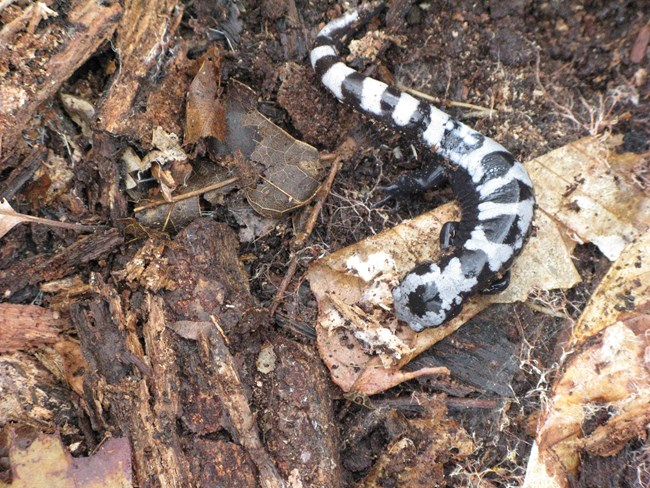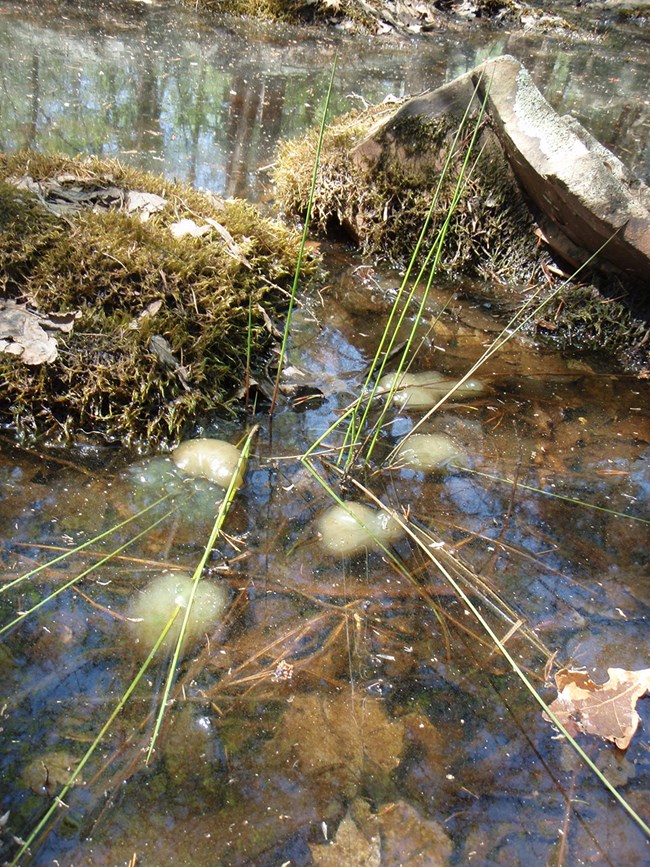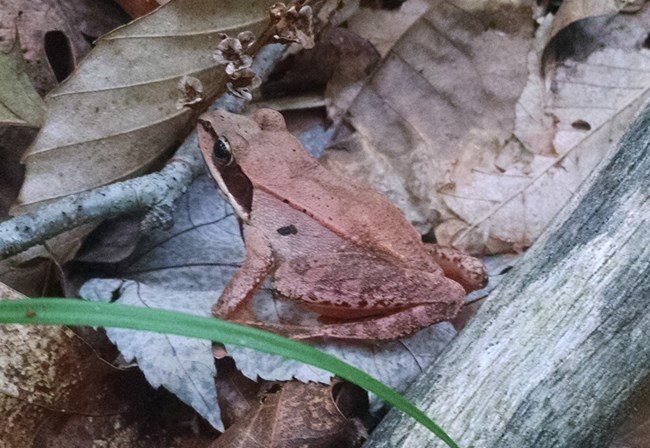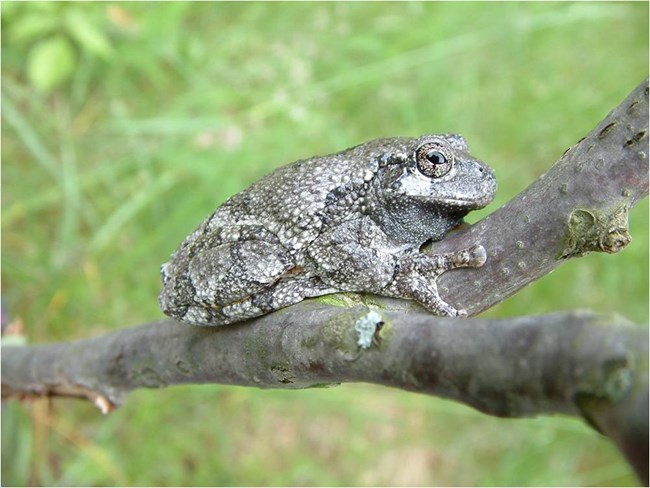Last updated: April 12, 2022
Article
Spring Amphibian Timeline

NPS/Dan Sealy
by Alex Wright, NCRN I&M Amphibian Monitoring collaborator, Michigan State University
Spring is right around the corner, and with spring comes the start of most amphibian breeding within the parks (and the start of data collection for Inventory & Monitoring’s March to July amphibian monitoring program). So, what should park staff and visitors be on the lookout for and when?
One of the first species to kick off the breeding season in the National Capital Region (NCR) is the marbled salamander (Ambystoma opacum), which gets a head start on other local amphibian species by breeding on rainy nights the previous fall. Most NCR amphibians lay their eggs in ephemeral wetlands, that dry up in late summer or early fall. But marbled salamanders lay their eggs during fall in the dry wetland beds, often on the underside of leaves or other debris. Their eggs hatch after the dry beds fill up with winter precipitation. Marbled salamander larvae can typically be found through dipnet surveys from March through late May. Adults, characterized by stout bodies and silver banding across a black back, live mostly underground (fossorial) and are not usually seen except during the fall breeding events.

NPS/Nortrup
Next in the line up, are two of the earliest spring breeders: the spotted salamander (Ambystoma maculatum) and wood frog (Rana sylvaticus). These species produce the first egg masses of the year. The spotted salamander lays egg masses which are often oval, compact, and enveloped by a cloudy “jelly” layer. They are laid during mass breeding events on rainy nights in early spring usually in or near inundated wetlands. The spotted salamanders have an elaborate “nudging” courtship ritual in which they dance around and nudge potential mates with their chin. Wood frogs similarly have “explosive” breeding events during early spring rains. This happens shortly after the wood frogs literally thaw out from winter hibernation in leaf litter burrows where they are protected by a natural antifreeze that keeps the inside of their bodies from freezing.

NPS/Andrejs Brolis
Wood frog egg masses, often containing up to thousands of eggs per clutch, are circular, compact, and clear. Adult wood frogs, characterized by a dark “robber mask” on their faces, can be seen hopping around the forest floor throughout the breeding season. Adult spotted salamanders with bright yellow spots on their dark-purplish backs however, are generally only seen during their large, spring breeding events, spending the rest of the year underground like the closely related marbled salamander.
As temperatures rise and spring really comes in to full swing, frog “choruses” start to be more commonly and consistently heard across the parks. In particular the calls of the spring peeper (Pseudacris crucifer) signal to many that spring has come. The characteristic “Peep-peep-peep…” chorus of spring peepers in large groups are often heard on warm spring nights. Perhaps giving rise to the saying, “When peepers sing loud and long and late, the weather will cooperate…”.

NPS
With spring peepers and gray tree frogs, also come a profusion of amphibian species including cricket frogs, bullfrogs, toads, and newts. The figure below shows when each is most easily observed during spring breeding season. Then things begin to slow down in July as summer temperatures rise and ephemeral wetlands begin to dry up. Only to start a new cycle the next year.
Note
This article was inspired by the figure below from a recent scientific journal publication: Wright, A.D., Grant, E.H.C. & Zipkin, E.F. Landscape Ecol (2020). https://doi.org/10.1007/s10980-019-00963-z. The publication is summarized in this article on Amphibian Diversity & Habitat Connectivity.
This figure shows the average species-specific detection probabilities for various amphibian species during the amphibian breeding season in the Chesapeake & Ohio Canal National Historical Park (CHOH). The closer any line is to 1.00, the more likely that species is to be observed or detected. A line at 0 indicates a zero chance of finding that species. The solid black line shows the average of all species (with shaded dark grey showing the 50% credible interval and light grey the 95% credible intervals).
Tags
- antietam national battlefield
- baltimore-washington parkway
- catoctin mountain park
- chesapeake & ohio canal national historical park
- fort dupont park
- fort washington park
- george washington memorial parkway
- great falls park
- greenbelt park
- harpers ferry national historical park
- manassas national battlefield park
- monocacy national battlefield
- piscataway park
- prince william forest park
- rock creek park
- wolf trap national park for the performing arts
- ncrn
- amphibians
- frogs
- salamanders
- inventory and monitoring
- ncr
- marbled salamander
- spotted salamander
- wood frog
- spring peeper
- gray tree frog
- natural resource quarterly
- spring 2020
